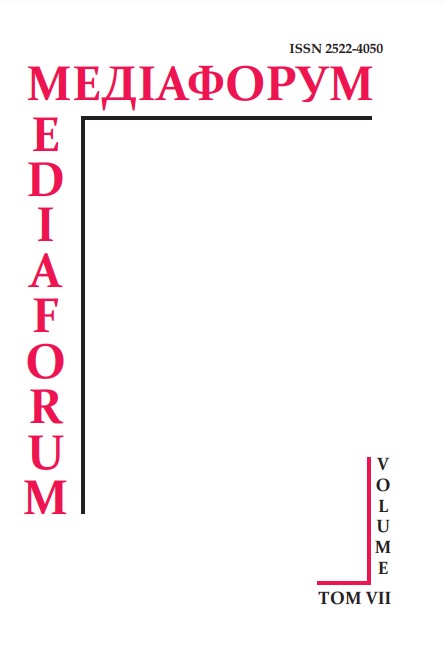“Hate speech” as Technology for Conducting the Hybrid War of the Russian Federation Against Ukraine
DOI:
https://doi.org/10.31861/mediaforum.2019.7.250-259Keywords:
hate speech, haters, information war, hybrid war, Russia, UkraineAbstract
The following material is an attempt to analyze the problem of use of new media in the context of Ukrainian-Russian conflict, to explain the «hate speech» as a technology for hybrid warfare and the causes of its occurrence. It is described the issues of the use of hate speech in the East of Ukraine and on the occupied territory of the Crimea.
In addition, this research identifies the main social groups against which Russian Federation uses «hate speech». In particular, they are Ukrainians (especially from Western Ukraine), Crimean Tatars, Euromaidan supporters, members of the Majlis of the Crimean Tatar people, сhurchmans, migrants.
On the basis of researches of public organizations («Media Detector», «Center for Social Action», «Institute of Mass Media», «Donetsk Institute of Information») in this paper work a qualitative analysis of the situation in the media space is presented. The focus is on the emergence of the phenomenon of intolerance in the media. In addition, it is determined which media often use «hate speech» in their arsenal both from Ukraine and from the Russian Federation.
The researcher states that the problem of using «hate speech» in the information space of Ukraine, in particular, Crimea and the eastern regions existed before the occupation. However, from the first days of the hybrid offensive of the Russian Federation, hate speech began to be used in propaganda, and hostile rhetoric became more aggressive.
We should note that by supporting the high level of anxiety and hatred in the occupied territory of Ukraine through the media, Russia is creating a platform to create a civil conflict, if necessary. In addition, «hate speech» is used by the Russian authorities to form publicly supportive policy on the territory of the Russian Federation.
Downloads
References
Analiz internet-ZMI t.zv. “DNR” ta “LNR”: u kozhnii desiatii novyni – mova vorozhnechi shchodo ukraintsiv, 11% novyn – feiky», Instytut masovoi informatsii, 2017. https://imi.org.ua/news/analizinternet-zmi-tzv-dnr-ta-lnr-u-kojniy-desyatiy-novini-mova-vorojnechischodo-ukrajintsiv-11-i17084.
«Vragi Rossii». ANO «Levada-tsentr», Analiticheskiy tsentr Yuriya Levady, 2018. https://www.levada.ru/2018/01/10/vragi-rossi. (accessed May10, 2019).
Drukovani vydannia ORDO na 26% skladaiutsia z movy vorozhnechi – doslidzhennia DII, Detektor Media, 2017. http://detector.media/infospace/article/127569/2017-07-03-drukovani-vidannya-ordona-26-skladayutsyaz-movi-vorozhnechi-doslidzhennya-dii/
Mova vorozhnechi u ZMI : yakoiu vona buvaie ta do choho pryzvodyt (infohrafika), Instytut masovoi informatsii, 2016. https://imi.org.ua/advices/mova-vorojnechi-u-zmi-yakoyu-vona-buvae-ta-dochogo-prizvodit-infografika-i2374.
Mova vorozhnechi, Vikipediia, ostannia zmina 7 serpnia, 2019. https://uk.wikipedia.org/wiki/Мова_ворожнечі.
Unykannia movy vorozhnechi nablyzyt myr, Media Sapiens, 2015. http://osvita.mediasapiens.ua/ethics/standards/unikannya_movi_vorozhnechi_nablizit_mir/.
Tsentr Sotsialna diia zafiksuvav 424 vypadky vzhyvannia movy vorozhnechi v ukrainskykh ZMI za 2014 rik», Media Sapiens, 2015. https://ms.detector.media/mediaprosvita/research/tsentr_sotsialna_diya_zafiksuvav_424_vipadki_vzhivannya_movi_vorozhnechi_v_ukrainskikh_zmi_za_2014_rik/.
«Tsyganskiy baron», «zechki» i «rashisty»: kak vsyu vesnu zaporozhskie SMI tirazhirovali vrazhdebnost», Detektor Medіa, 2017. http://detector.media/infospace/article/127783/2017-07-07-tsyganskiibaron-zjechki-i-rashisty-kak-vsyuvesnu-zaporozhskie-smi-tirazhirovalivrazhdebnost/
Hate speech, Xenodocuments, 2007. http://www.xenodocuments.org.ua/.
Aleksandr Burmagin i dr., Yazyk vrazhdy v informatsionnom prostranstve Kryma: Informatsionno-analiticheskiy doklad o rasprostranenii yazyka vrazhdy na territorii Krymskogo poluostrova (mart 2014 – iyul 2017), (Kiev, pod obshchey redaktsiey I. Sedovoy i T. Pechonchik, 2018, 35). https://crimeahrg.org/wp-content/uploads/2018/03/Hatebook-RU.pdf.
Elli Kin, Mara Heorhesku, Zakladnyky. Posibnyk z protydii movi nenavysti onlain cherez osvitu z prav liudyny», 2016, 143. https://rm.coe.int/16806f9aec.
Olha Horbachova, Mova vorozhnechi : ksenofobiia chy bezladnist, 2008. https://library.fes.de/pdf-files/bueros/ukraine/06708.pdf.















